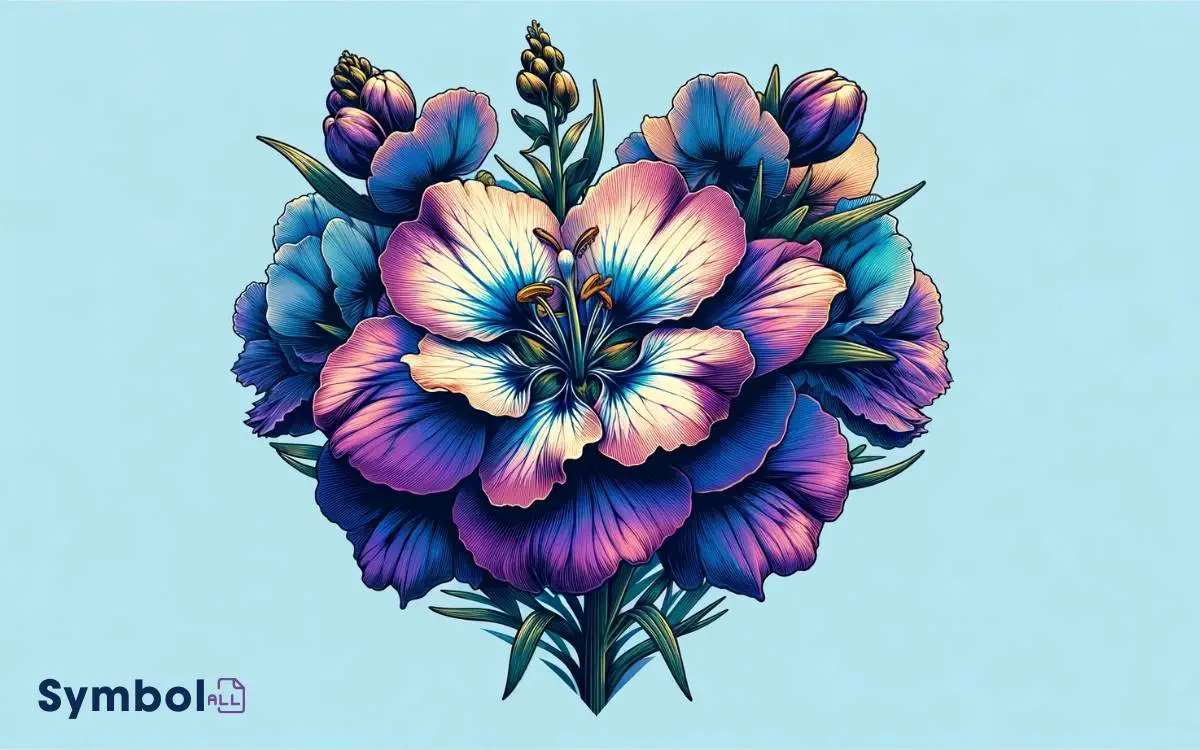What Does a Larkspur Flower Symbolize? Protection!
Larkspur, or Delphinium spp., symbolizes a myriad of meanings, rooted in its ecological and cultural milieu.
Its racemes, adorned with shades from soft pinks to deep purples, convey messages from fickleness to first love, mirroring the complex interactions within ecosystems.
Alkaloids like delphinine, underscore its role in protection, acting as natural defenses, while its morphology with a prominent spur exemplifies safeguarding. As a pollinator magnet, larkspur underscores biodiversity, enhancing ecosystem health.
Each color variation not only represents emotional narratives but also symbolizes unique adaptations to attract specific pollinators.
Revealing these colors’ significance offers a deeper insight into the symbiotic relationships larkspur upholds.

Key Takeaways
Historical Significance
Delving into history, you’ll find that larkspur flowers, known scientifically as Delphinium spp., have played a multifaceted role in various cultures due to their distinctive morphology and ecological significance.
With elongated racemes and a range of hues from deep blues to vibrant purples, these perennials haven’t only captivated the aesthetic sensibilities of gardeners but also served in medicinal and ceremonial capacities.
Their alkaloid-rich compounds, while toxic, were historically harnessed for their therapeutic properties, treating ailments from lice infestations to scorpion stings.
In an ecological context, larkspurs contribute to biodiversity, attracting pollinators such as bees and butterflies, playing a pivotal role in the maintenance of healthy ecosystems. This intricate interplay between form, function, and symbolism underscores the larkspur’s enduring legacy.
Love and Affection
Beyond their ecological contributions, larkspur flowers symbolize deep-seated emotions of love and affection, reflecting a rich tapestry of meanings that vary by color and context.
These plants, belonging to the genus Delphinium, exhibit a diverse range of hues, each conveying a unique message within the spectrum of love.
- Pink Larkspurs: Often symbolize fickleness, serving as a gentle reminder of the fluctuating nature of affection.
- White Larkspurs: Represent a pure heart, conveying feelings of ardent love without the shadow of deceit.
- Purple Larkspurs: Signify first love, capturing the essence of deep and enduring affection that marks the inception of romantic feelings.
Understanding these color-coded messages allows you to appreciate not just the botanical beauty but also the profound emotional resonance of larkspur flowers. Each hue of the larkspur carries a unique sentiment, from the excitement of new beginnings represented by pink to the grace and dignity embodied by white. This delicate interplay of colors evokes the timeless connection between nature and human emotion, much like the lotus flower meaning and symbolism, which often represents purity, enlightenment, and resilience. Together, these floral interpretations deepen our appreciation for the way blooms can communicate intricate, unspoken feelings.
Protection and Safety
Larkspur flowers not only captivate with their vivid hues but also serve as symbols of protection and safety, embodying a lesser-known aspect of their botanical significance.
Within the domain of flora, these enchanting blooms exhibit unique alkaloids, specifically delphinine, which offer a natural defense mechanism against herbivorous predators.
This chemical compound, while lending a layer of protection to the plant, metaphorically translates to a symbol of safeguarding in human culture.
Their intricate morphology, with a spur that seemingly guards the flower’s reproductive organs, further illustrates their role as protectors.
When you integrate larkspurs into your garden or home, you’re not just embracing their aesthetic appeal but also invoking an ancient emblem of safety, warding off negativity and preserving the sanctity of your space.
Lightness and Levity
While larkspurs offer protection with their toxic alkaloids, they also embody lightness and levity through their delicate structure and the way their blooms sway gracefully in the breeze.
This juxtaposition reflects the complexity of ecosystems where larkspurs thrive. They exhibit a fine balance between deterring herbivores and inviting pollinators.
- Delicate Morphology: Larkspurs have slender stems and finely divided leaves, contributing to their ethereal appearance.
- Swaying Blooms: The lightness of their floral structure allows them to dance in the wind, a serene spectacle.
- Ecological Role: Despite their toxicity, they play a crucial role in ecosystems, supporting pollinators and contributing to biodiversity.
Understanding larkspurs in this perspective underscores the marvel of nature’s design, where beauty and function are intricately linked.
Colors and Meanings
Delving into the palette of larkspur hues, you’ll uncover a spectrum of meanings, each color narrating a unique ecological and cultural story.
| Color | Meaning |
|---|---|
| Pink | Fickleness, whimsical love |
| White | Happiness, purity |
| Purple | First love, enchantment |
| Blue | Grace, dignity |
Each shade of the larkspur signifies a distinct ecological adaptation, alongside human emotional connections.
The pink variety, for instance, thrives in diverse ecological niches, symbolizing adaptability and change, akin to the fickleness of love.
White larkspurs, reflecting purity, often inhabit areas of serene beauty, emphasizing their association with joy and cleanliness.
Purple and blue varieties, with their deeper hues, are adapted to attract specific pollinators, mirroring the depths of human emotions like first love and dignity.
Conclusion
To sum up, your exploration of the symbolism of larkspur flowers uncovers a diverse array of meanings. With a rich historical background, these blossoms represent love, tenderness, safeguarding, and a sense of airiness.
Each hue conveys its own special significance, from unwavering loyalty in blue to a receptive demeanor in pink.
Keep in mind, ‘beauty is in the eye of the beholder,’ and within the intricate structure and environmental functions of larkspurs, you encounter a world mirroring the intricacy and allure of human emotions.






